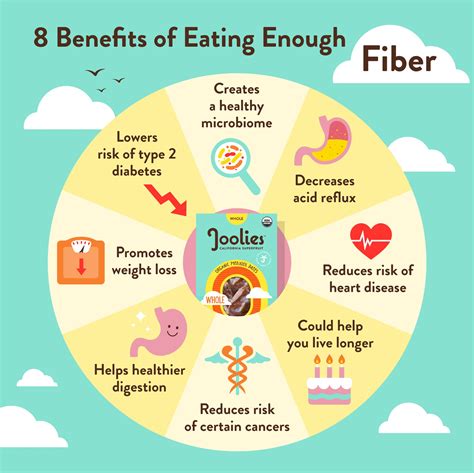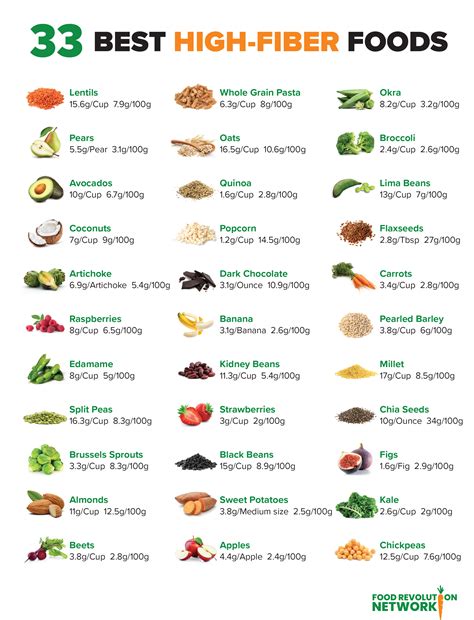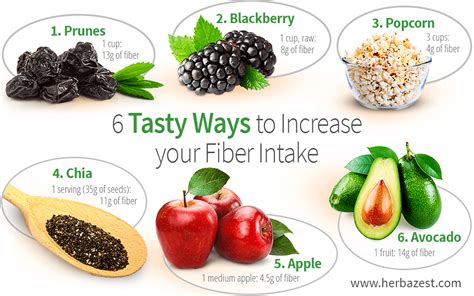Intro
Boost digestion with 5 high-fiber foods, including fruits, veggies, and whole grains, rich in dietary fiber, soluble fiber, and insoluble fiber for a healthy gut and weight management.
Eating a diet rich in fiber has numerous health benefits, including promoting digestive health, supporting healthy blood sugar levels, and even aiding in weight management. Despite these benefits, many people do not consume enough fiber in their daily diets. The recommended daily intake of fiber is 25-30 grams per day, but the average person consumes much less than this. Increasing fiber intake can be simple by incorporating high-fiber foods into your meals. In this article, we will explore the importance of fiber, the benefits of a high-fiber diet, and highlight 5 foods that are high in fiber.
A high-fiber diet can have a significant impact on overall health and wellbeing. Fiber helps to promote regular bowel movements, prevent constipation, and support the growth of beneficial gut bacteria. A diet rich in fiber can also help to lower cholesterol levels, reduce inflammation, and improve blood sugar control. Furthermore, fiber can help to keep you feeling fuller for longer, making it easier to manage weight. With so many benefits, it's no wonder that health professionals recommend increasing fiber intake.
In addition to the health benefits, incorporating high-fiber foods into your diet can be delicious and easy. High-fiber foods include a variety of fruits, vegetables, whole grains, and legumes. These foods are not only rich in fiber but also provide essential vitamins, minerals, and antioxidants. By making a few simple changes to your diet, you can increase your fiber intake and start experiencing the benefits of a high-fiber diet. In the following sections, we will explore 5 foods that are high in fiber and provide tips on how to incorporate them into your meals.
Introduction to High-Fiber Foods

Benefits of a High-Fiber Diet

Key Benefits of Fiber
Some of the key benefits of fiber include: * Promoting digestive health * Supporting healthy blood sugar levels * Aiding in weight management * Lowering cholesterol levels * Reducing inflammation * Improving blood sugar control5 Foods High in Fiber

Tips for Incorporating High-Fiber Foods
Some tips for incorporating high-fiber foods into your diet include: * Adding fruits and vegetables to oatmeal or yogurt * Using whole grains instead of refined grains * Incorporating legumes into meals * Snacking on nuts and seeds * Drinking plenty of water to help fiber move through the digestive systemIncreasing Fiber Intake

Common Mistakes to Avoid
Some common mistakes to avoid when increasing fiber intake include: * Increasing fiber intake too quickly * Not drinking enough water * Not incorporating a variety of high-fiber foods into meals * Relying on supplements instead of whole foodsConclusion and Next Steps

We hope this article has provided you with the information and inspiration you need to start increasing your fiber intake. If you have any questions or comments, please don't hesitate to reach out. Share this article with friends and family who may benefit from learning more about the importance of fiber. Take the first step towards a healthier, happier you by incorporating high-fiber foods into your diet today.
What is the recommended daily intake of fiber?
+The recommended daily intake of fiber is 25-30 grams per day.
What are some common high-fiber foods?
+Some common high-fiber foods include avocados, legumes, whole wheat spaghetti, Brussels sprouts, and almonds.
How can I increase my fiber intake?
+You can increase your fiber intake by incorporating high-fiber foods into your meals, drinking plenty of water, and gradually increasing your fiber intake over time.
